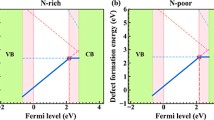Abstract
The geometric structure, band structure (BS) and density of state (DOS) of pure and p-type co-doping wurtzite ZnO have been investigated by the first-principle ultrasoft pseudopotential method with the generalized gradient approximation. These structures induce fully occupied defect states above the valence-band maximum of doped ZnO. The calculation results show that in the range of high doping concentration, when the co-doping concentration is more than a certain value, the conductivity decreased with the increase of co-doping concentration of Ag–2N in ZnO. Our findings suggest that co-doping of Ag–2N could efficiently enhance the N dopant solubility and is likely to yield better p-type conductivity.




Similar content being viewed by others
References
Lide D R (ed) 2007–2008 CRC handbook of chemistry and physics (Boca Raton, FL : CRC Press) 88th ed
Pearton S J, Norton D P, Ip K, Heo Y W and Steiner T 2004 J. Vac. Sci. Technol. B 22 932
Zhang S B, Wei S -H and Zunger A 2001 Phys. Rev. B 63 075205
Yan Y F, Al-Jassim M M and Wei S H 2006 Appl. Phys. Lett. 89 181912
Vaithianathan V, Lee B T and Kim S S 2005 Appl. Phys. Lett. 86 062101
Wang P, Chen N and Yin Z G 2006 Appl. Phys. Lett. 88 152102
Kang H S, Ahn B D, Kim J H, Kim G H, Lim S H, Chang H W and Lee S Y 2006 Appl. Phys. Lett. 88 202108
Park C H, Zhang S B and Wei S -H 2002 Phys. Rev. B 66 073202
Wei S H 2004 Comput. Mater. Sci. 30 337
Chen K, Fan G H, Zhang Y and Ding S F 2008 Acta Phys. Chim. Sin. 24 61
Guo X L, Tabata H and Kawai T 2001 J. Cryst. Growth 223 135
Zuo C Y, Wen J and Bai Y L 2010 Chin. Phys. B 19 047101
Bian J M, Li X M and Zhang C Y 2004 Appl. Phys. Lett. 85 4070
Duan X M, Stampfl C, Bilek M M M and McKenzie D R 2009 Phys. Rev. B 79 235208
Wan Q X, Xiong Z H, Dai J N, Rao J P and Jiang F Y 2008 Opt. Mater. 30 817
He H Y, Hu J and Pan B C 2009 J. Chem. Phys. 130 (c) 204516
Gelves G A, Lin B, Sundararaj U and Haber J A 2006 Adv. Funct. Mater. 16 2423
Delley B 1990 J. Chem. Phys. 92 508
Perdew J P, Burke K and Ernzerhof M 1996 Phys. Rev. Lett. 77 3865
Davidson E R and Chakravorty S 1992 Theor. Chim. Acta 83 319
Wang B L, Zhao J J, Chen X S, Shi D and Wang G H 2006 Nanotechnology 17 3178
Segall M D, Shah R, Pickard C J and Payne M C 1996 Phys. Rev. B 54 16317
Özgür Ú, Alivov Y I, Liu C, Teke A, Reshchikov M A, Doğan S, Avrutin V, Cho S J and Morkoc H 2005 J. Appl. Phys. 98 041301
Hou Q Y, Li J J, Zhao C W, Ying C and Z. Y 2011 Physica B 406 1956
Abrahams S C and Bemstein J L 1969 Acta Crystallogr. B 25 1233
He C, Qi L, Zhang W X and Pan H 2011 Appl. Phys. Lett. 99 073105
Zuo C Y, Wen J and Bai Y L 2010 Chin. Phys. B 19 047101
Vanderbilt D 1990 Phys. Rev. B 41 7892
Huang K and Han N 1985 Solid state physics (Beijing : Higher Education Press)
Acknowledgements
We acknowledge supports by National Key Basic Research and Development Program (Grant nos 2010CB631001 and 2012CB619400), National Natural Science Foundation of China (NSFC, Grant nos 51101117 and 51301020), Ph.D. Programs Foundation of Ministry of Education of China (Grant no. 20110201120002), the Natural Science Basic Research Plan in Shaanxi Province of China (2011JQ6001) and the Fundamental Research Funds for the Central Universities and State Key Laboratory for Mechanical Behavior of Materials.
Author information
Authors and Affiliations
Corresponding author
Rights and permissions
About this article
Cite this article
ZHANG, W., BAI, Y., HE, C. et al. First-principle study on the effect of high Ag–2N co-doping on the conductivity of ZnO. Bull Mater Sci 38, 747–751 (2015). https://doi.org/10.1007/s12034-015-0897-9
Received:
Revised:
Published:
Issue Date:
DOI: https://doi.org/10.1007/s12034-015-0897-9




